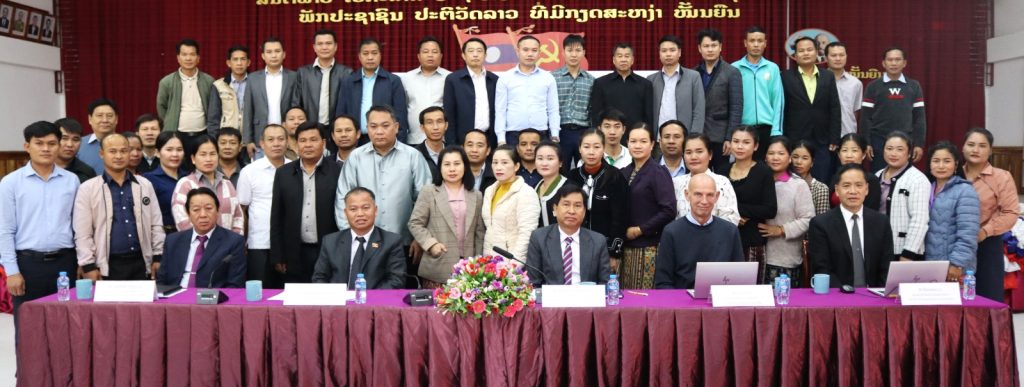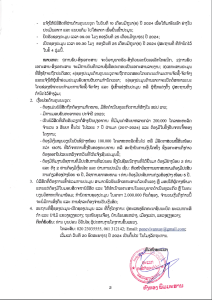[English below] ອົງການ FAO ສະໜັບສະໜູນຊຸກຍູ້ຊາວກະສິກອນລາວສົ່ງອອກງົວໄປປະເທດຈີນ/FAO supports Lao farmers to boost cattle trade to China
ອົງການ FAO ສະໜັບສະໜູນຊຸກຍູ້ຊາວກະສິກອນລາວສົ່ງອອກງົວໄປປະເທດຈີນ
ອົງການອາຫານ ແລະ ການກະເສດ ແຫ່ງສະຫະປະຊາຊາດ (FAO) ໂດຍຜ່ານສູນສຸກເສີນເພື່ອຄວບຄຸມພະຍາດລະບາດສັດຂ້າມແດນ (ECTAD) ຮ່ວມກັບ ກົມລ້ຽງສັດ ແລະ ການປະມົງ, ກະຊວງກະສິກໍາ ແລະ ປ່າໄມ້, ໄດ້ເປີດຊຸດຝຶກອົບຮົມ ເປັນເວລາ 2 ອາທິດ, ໃນລະຫວ່າງ ວັນທີ 6-17 ກຸມພາ 2023 ກ່ຽວກັບ: ການຄຸ້ມຄອງການກັກກັນສັດ ທີ່ເມືອງສິງ, ແຂວງຫຼວງນໍ້າທາ. ຊຶ່ງເປັນເຂດຊາຍແດນ ລະຫວ່າງ ສປປ ລາວ ແລະ ສປ ຈີນ, ຊຸດຝຶກອົບຮົມໄດ້ແນໃສ່ເພື່ອເລັ່ງລັດການຄ້າງົວທີ່ປອດໄພ ລະຫວ່າງສອງປະເທດ ແລະ ປັບປຸງການສົ່ງອອກງົວໄປປະເທດຈີນ.

ກິດຈະກຳດັ່ງກ່າວ ເປັນສ່ວນໜຶ່ງຂອງໂຄງການຮ່ວມມືທາງດ້ານເຕັກນິກ ຂອງບັນດາປະເທດກໍາລັງພັດທະນາ ລະຫວ່າງ ອົງການ FAO ແລະ ປະເທດຈີນ ກ່ຽວກັບການຄວບຄຸມພະຍາດສັດຂ້າມແດນ ໃນອະນຸພາກພື້ນແມ່ນໍ້າຂອງ (GMS) ຊຶ່ງໄດ້ຮັບທຶນຊ່ວຍເຫຼືອຈາກກະຊວງກະສິກຳ ແລະ ຊົນນະບົດ, ສປ ຈີນ (MARA) ພາຍໃຕ້ການຮ່ວມມືຢ່າງໃກ້ຊິດກັບກົມລ້ຽງສັດ ແລະ ການປະມົງ (DLF), ກະຊວງກະສິກຳ ແລະ ປ່າໄມ້, ສປປ ລາວ.
ເຈົ້າໜ້າທີ່ກັກກັນສັດ ແລະ ນັກວິຊາການຮັກສາສຸຂະພາບສັດຂອງລາວ, ຊາວກະສິກອນ, ຊາວກະສິກອນຜູ້ລ້ຽງສັດ ແລະ ສັດຕະວະແພດບ້ານ ຈະໄດ້ຮຽນຮູ້ເງື່ອນໄຂການກັກກັນ ແລະ ຂໍ້ກໍານົດດ້ານສຸຂະພາບຕ່າງໆສໍາລັບງົວ ທີ່ຈະສົ່ງອອກໄປປະເທດຈີນຊຶ່ງມາດຕະການດັ່ງກ່າວໄດ້ຖືກລົງນາມໂດຍກົມຄຸ້ມຄອງພາສີຈີນ (GACC) ແລະ ກະຊວງກະສິກໍາ ແລະ ປ່າໄມ້ (MAF) ໃນປີ 2019 ແລະ ໄດ້ຖືກປັບປຸງໃນປີ 2022. ພາຍໃຕ້ມາດຕະການດັ່ງກ່າວ, ງົວຕ້ອງໄດ້ຖືກກັກກັນເພື່ອລ້ຽງທອມຢູ່ເຂດທ້ອນໂຮມສັດເປັນເວລາ 45 ວັນ ແລະ ເຂດກັກກັນເປັນເວລາ 30 ວັນ ຢູ່ເມືອງສິງ, ກ່ອນຈະຖືກສົ່ງອອກໄປປະເທດຈີນ. ມາດຕະການດັ່ງກ່າວໄດ້ຖືກອະນຸມັດ ເພື່ອຫຼຸດຜ່ອນຄວາມສ່ຽງຕໍ່ການສົ່ງຕໍ່ຂອງພະຍາດປາກເປື່ອຍລົງເລັບ (FMD) ແລະ ພະຍາດຜິວໜັງອັກເສບຕິດຕໍ່ງົວ-ຄວາຍ (LSD) – ຊຶ່ງເປັນສອງພະຍາດສັດລ້ຽງ ທີ່ພົບທົ່ວໄປໃນປະເທດ ຕະຫຼອດຕ່ອງໂສ້ມູນຄ່າ.

ການຄວບຄຸມພະຍາດລະບາດສັດຂ້າມແດນທີ່ດີ ຈະບໍ່ພຽງແຕ່ປັບປຸງຊີວິດການເປັນຢູ່ຂອງຊຸມຊົນກະສິກຳເທົ່ານັ້ນ, ແຕ່ຍັງຊຸກຍູ້ການເຕີບໂຕທາງດ້ານເສດຖະກິດ ໂດຍການຊຸກຍູ້ການສົ່ງອອກໄປຍັງປະເທດໃກ້ຄຽງ. ອີງຕາມຂໍ້ມູນຈາກອົງການບໍລິຫານພາສີ ແຫ່ງ ສປ ຈີນ (GACC), ໃນປີ 2022 ຊີ້ນງົວຫຼາຍກວ່າ 2,3 ລ້ານໂຕນ ໄດ້ຖືກນໍາເຂົ້າໄປປະເທດຈີນຈາກທົ່ວໂລກ, ຊຶ່ງໃນນັ້ນ ນໍາເຂົ້າຈາກ ສປປ ລາວ ມີໜ້ອຍ ກ່ວາ 1 ເປີເຊັນ.
ທ່ານ ນາງ ວິໄລພອນ ວໍລະພິມ ຫົວໜ້າກົມລ້ຽງສັດ ແລະ ການປະມົງ ໄດ້ຊົມເຊີຍແນວຄວາມຄິດລິເລີ່ມສາມຝ່າຍນີ້ “ປະເທດຂອງພວກເຮົາ ມີລາຍຮັບຈາກການສົ່ງອອກສັດລ້ຽງໄປຍັງປະເທດຈີນ 54 ລ້ານໂດລາສະຫະລັດຕໍ່ປີ, ທີ່ລັດຖະບານໄດ້ວາງເປົ້າໝາຍຊຸກຍູ້ການສົ່ງອອກງົວ ໃຫ້ບັນລຸລາຍຮັບເຖິງ 100 ລ້ານໂດລາສະຫະລັດ ໃນປີ 2023,” ທ່ານ ນາງ ວິໄລພອນ ວໍລະພິມ ໄດ້ກ່າວອີກວ່າ: ປະເທດຈີນໄດ້ສະເໜີໂຄຕ້ານໍາເຂົ້າງົວໃຫ້ແກ່ ສປປ ລາວ ເຫັນວ່າມັນເປັນທ່າແຮງທີ່ດີໃຫ້ແກ່ຊາວກະສິກອນລາວ ກາຍເປັນຜູ້ສົ່ງອອກງົວທີ່ໃຫຍ່ກວ່າເກົ່າ. ພວກເຮົາສະໜັບສະໜູນຊາວກະສິກອນລາວ ໃນການປະຕິບັດຕາມຂໍ້ກຳນົດຕ່າງໆທີ່ວາງອອກຈາກຝ່າຍຈີນ.
ຄຽງຄູ່ກັນນັ້ນ, ອົງການ FAO ໄດ້ສະໜັບສະໜູນລັດຖະບານ ແຫ່ງ ສາທາລະນະລັດ ປະຊາທິປະໄຕ ປະຊາຊົນລາວ ຢ່າງຕໍ່ເນື່ອງ ໃນການເພີ່ມທະວີຄວາມສາມາດເພື່ອປ້ອງກັນ, ກວດວິໄຈ ແລະ ຄວບຄຸມພະຍາດສັດ. ທ່ານ ກາເຈັນ ວົງສະຖາພອນໃຈ ຜູ້ຈັດການພາກພື້ນອາຊີ ແລະ ປາຊີຟິກ ຂອງອົງການ FAO ECTAD, ໄດ້ກ່າວວ່າ: “ພວກເຮົາດີໃຈຫຼາຍທີ່ໄດ້ເຮັດວຽກຮ່ວມກັບກົມລ້ຽງສັດ ແລະ ການປະມົງ ແລະ ກະຊວງກະສິກຳ ແລະ ຊົນນະບົດ, ສປ ຈີນ ເພື່ອສົ່ງເສີມການຄ້າງົວທີ່ປອດໄພ ໃຫ້ແກ່ຊາວກະສິກອນ ແລະ ອຳນາດການປົກຄອງຂອງລາວ. ການຫຼຸດຜ່ອນຄວາມສ່ຽງຂອງພະຍາດສັດຕາມລະບົບຕ່ອງໂສ້ມູນຄ່າຂ້າມຊາຍແດນ ຈະເຮັດໃຫ້ງົວມີສຸຂະພາບດີຂຶ້ນກວ່າເກົ່າ ແລະ ຊາວກະສິກອນມີຄວາມສຸກຫຼາຍຂຶ້ນ”.
ທ່ານ ຊູ ມິງ ຮອງຫົວໜ້າກົມ, ສູນກາງການບໍລິການຮ່ວມມືສາກົນ ຂອງພະແນກການຮ່ວມມືສາກົນ, ກະຊວງກະສິກໍາ ແລະ ຊົນນະບົດ (MARA CICOS) ຂອງ ສປ ຈີນ, ໃຫ້ຮູ້ວ່າ: “ປະເທດຈີນຍາມໃດກໍຖືສຳຄັນການແລກປ່ຽນ ແລະ ການຮ່ວມມືດ້ານກະສິກຳກັບບັນດາປະເທດໃນເຂດພາກພື້ນ ອາຊີ-ປາຊີຟິກ”.
ອະນຸພາກພື້ນແມ່ນໍ້າຂອງຕອນເທິງ (GMS) ດ້ວຍພື້ນຖານດັ່ງກ່າວນັ້ນ, ກະຊວງກະສິກຳ ແລະ ຊົນນະບົດ, ສປ ຈີນ ໄດ້ປະ ກອບສ່ວນເຂົ້າໃນແຜນງານການຄວບຄຸມພະຍາດລະບາດສັດຂ້າມແດນ ຂອງປະເທດອານຸພາກພື້ນແມ່ນໍ້າຂອງ. ຍ້ອນຄວາມພະຍາ ຍາມ ແລະ ການຮ່ວມມືກັນຢ່າງສະໜິດແໜ້ນ ກັບອົງການ FAO, ການສະໜັບສະໜູນດ້ານເຕັກນິກ ໄດ້ຖືກສະໜອງໃຫ້ເພື່ອປັບ ປຸງເນື້ອໃນ ແລະ ການສົ່ງເສີມການຄ້າງົວຂອງ ສາທາລະນະລັດ ປະຊາທິປະໄຕ ປະຊາຊົນລາວ ກັບ ປະເທດຈີນ.”
ໃນອາທິດຕໍ່ໜ້າ, ອົງການ FAO, ກະຊວງກະສິກຳ ແລະ ຊົນນະບົດ, ສປ ຈີນ ແລະ ກົມລ້ຽງສັດ ແລະ ການປະມົງ ຈະເປີດຂະບວນການສັກຢາກັນພະຍາດ ພະຍາດປາກເປື່ອຍລົງເລັບ ແລະ ພະຍາດຜິວໜັງອັກເສບຕິດຕໍ່ງົວ-ຄວາຍ, ໃນ 5 ເມືອງຂອງແຂວງຫຼວງນ້ຳທາ, ຊຶ່ງກວມເອົາງົວທັງໝົດ ເຖິງ 40.000 ໂຕ ໃນຂົງເຂດດັ່ງກ່າວ. ພ້ອມກັນນັ້ນ, ຈະສະໜອງເຄື່ອງມືອຸປະກອນທຳຄວາມສະອາດ ແລະ ຂ້າເຊື້ອ ໃຫ້ແກ່ 18 ແຂວງໃນທົ່ວປະເທດ ເພື່ອຊ່ວຍໃຫ້ຊາວກະສິກອນປ້ອງກັນສັດລ້ຽງຈາກໄພຂົມຂູ່ຈາກພະຍາດສັດຕ່າງໆ.
FAO Lao PDR Media Contact Person/s:
Bounmee Maokhamphiou, FAO Lao PDR Outreach Specialist, Bounmee.Maokhamphiou@fao.org
Vilaylack Khounvisith, FAO Lao PDR National Communications Consultant, Vilaylack.Khounvisith@fao.org
FAO RAP Media Contact Person/s:
Allan Dow, FAO Regional Communications Officer, Allan.Dow@fao.org
Rindu Putri, FAO ECTAD Regional Communications Specialist, Rindu.Putri@fao.org
FAO supports Lao farmers to boost cattle trade to China
Luang Namtha Province, Lao People’s Democratic Republic – The Food and Agriculture Organization of the United Nations (FAO), through its Emergency Centre for Transboundary Animal Diseases (ECTAD), kicked off a two-week training course on animal quarantine management in Sing District, a border area between Lao People’s Democratic Republic and China. The training course aimed to accelerate safer cattle trade between the two countries and improve cattle export to China.
The activity is part of the FAO-China South-South Cooperation Project on transboundary animal diseases control in the Greater Mekong Subregion (GMS), funded by the Ministry of Agriculture and Rural Affairs of the People’s Republic of China (MARA), and in close collaboration with the Department of Livestock and Fisheries (DLF) of the Lao People’s Democratic Republic’s Ministry of Agriculture and Forestry (MAF).
Lao animal quarantine and health officers, farmers, livestock traders and village veterinary workers are expected to learn quarantine and health requirements for cattle to be exported to China, which the protocol was signed by the General Administration of Customs of China (GACC) and MAF in 2019 and revised in 2022. In the protocol, cattle are required to be quarantined in the fattening zone for 45 days and quarantine zone for 30 days located in Sing District, before exporting to China. This protocol was released to minimize the risk of disease transmissions of foot-and-mouth disease (FMD) and lumpy skin disease (LSD) – two common livestock diseases in the country – along the value chain.
Better control of transboundary animal disease will not only improve the livelihoods of agricultural communities but also boost economic growth by stimulating exports to the neighbouring country. According to data from GACC, more than 2.3 million tonnes of beef were imported to China from all over the world in 2022, with only less than one percent coming from the Lao People’s Democratic Republic.
Better production, better life
The DLF Director-General Vilayphone Voraphim applauded this trilateral initiative. “Our country earned an annual income of USD 54 million from livestock exports to China. This activity comes at the right time as the government aims to boost cattle export, with a targeted USD 100 million profit in 2023,” as she highlighted that China has offered the cattle quota for Lao People’s Democratic Republic. “There is a great potential for Lao farmers to become bigger cattle exporters. We support Lao farmers in complying with requirements set by the Chinese authorities,” she added.
In parallel, FAO has continuously supported the Government of Lao People’s Democratic Republic to strengthen its capacity to prevent, detect and control animal diseases. “We are very pleased to work with DLF and MARA to promote safe cattle trade to Lao farmers and authorities. Reduction of animal disease risk along the cross-border value chain will lead to healthier cattle – and happier farmers,” said Kachen Wongsathapornchai, FAO ECTAD Regional Manager in Asia and the Pacific.
The MARA’s Center of International Cooperation Service (CICOS) Deputy Director-General Xu Ming noted that “China always attaches great importance to the agricultural exchange and cooperation with GMS countries. With that background, MARA contributed to GMS countries’ transboundary animal diseases control program. Thanks to the joint efforts and full collaboration with FAO, technical support has been provided for the revision of the text on the China-Lao People’s Democratic Republic beef cattle trade for its facilitation.”
In the coming weeks, FAO, MARA and DLF will launch the FMD and LSD vaccination campaigns in five districts of Luang Namtha Province, covering all 40 000 cattle in the area. Meanwhile, cleaning and disinfection equipment will be provided for all 18 provinces across the country to help farmers protect their livestock against animal disease threats.
FAO Lao PDR Media Contact Person/s:
Bounmee Maokhamphiou, FAO Lao PDR Outreach Specialist, Bounmee.Maokhamphiou@fao.org
Vilaylack Khounvisith, FAO Lao PDR National Communications Consultant, Vilaylack.Khounvisith@fao.org
FAO RAP Media Contact Person/s:
Allan Dow, FAO Regional Communications Officer, Allan.Dow@fao.org
Rindu Putri, FAO ECTAD Regional Communications Specialist, Rindu.Putri@fao.org
![[English below] ອົງການ FAO ສະໜັບສະໜູນຊຸກຍູ້ຊາວກະສິກອນລາວສົ່ງອອກງົວໄປປະເທດຈີນ/FAO supports Lao farmers to boost cattle trade to China](https://www.maf.gov.la/wp-content/uploads/2023/02/WhatsApp-Image-2023-02-15-at-14.04.08-150x150.jpeg)







